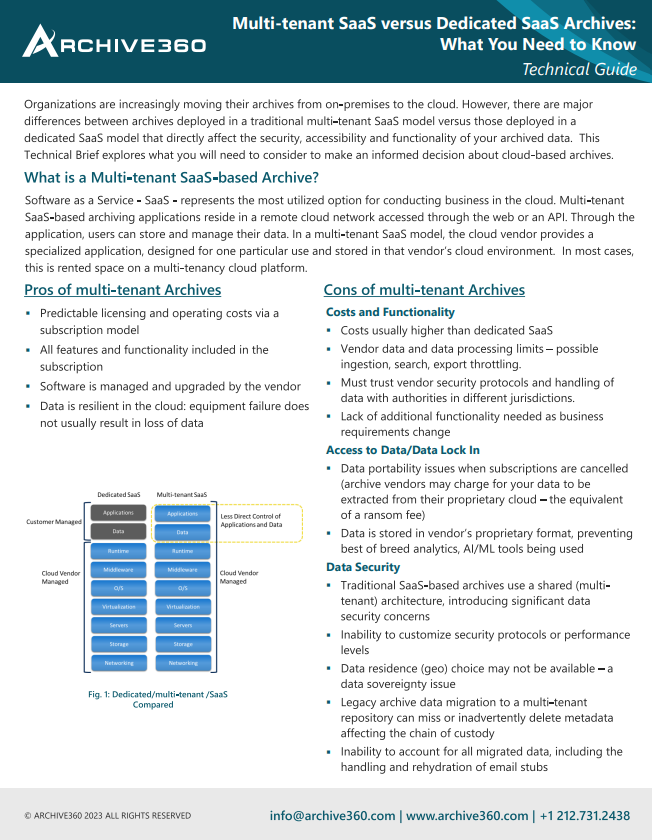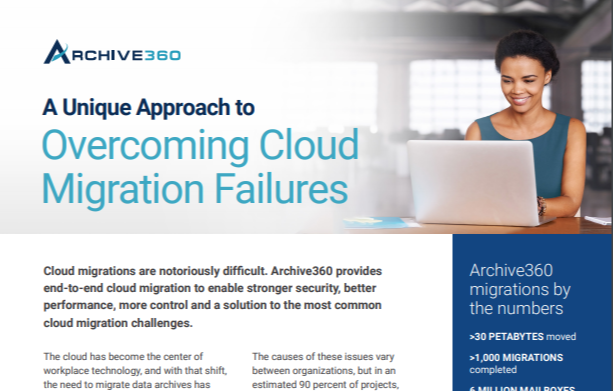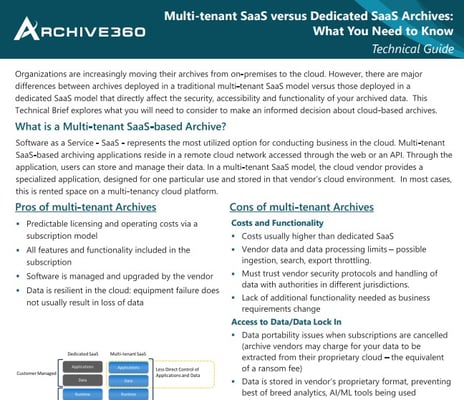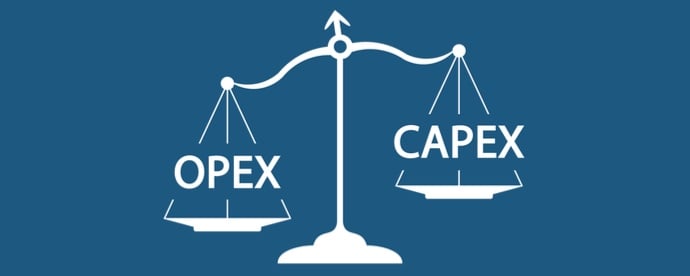Email Archive Migration for GWAVA Retain Unified Archiving
Break free from the limitations of your legacy, on-premises GWAVA email archive and unlock the value of your data with the secure cloud archive trusted by organizations worldwide.

Table of Contents
- Take Back Control of Your Data and its Security in the Cloud
- Option 1: A SaaS Colution
- Option 2: Your Own Public Cloud
- Option 2: The Trusted Cloud that You Control
- Consider the Need for Journals and Journal Migration
- Ensuring the Fastest, Most Accurate Migration to the Cloud
- Common Questions When Moving Away From GWAVA Retain Unified Archiving
Is Your Legacy Archive Holding You Back in Today’s Cloud-Centric Climate?
Whether you used GWAVA archiving before it was acquired by Micro Focus in 2016 or are using a post-2016 version of the solution, we understand your decision to use it. The simplicity it offered, the convenient regular billing cycle, and a hands-off approach were likely factors that helped make up your mind. But, whether you chose the solution yourself or inherited it, you’re likely now discovering that it’s not able to keep up with the changing markets, emerging regulations, and new demands of your business today.
With on-premises infrastructure becoming more costly to maintain and secure, a growing number of remote workers, the size and volume of emails increasing, and new file formats, from social media and instant messaging to audio and video files being introduced, legacy on-premises servers and SaaS solutions simply aren’t up to the task and are quickly becoming a costly burden for your business. The time has come to look for alternatives and, as is the case for many, corporate digital transformation initiatives such as the adoption of cloud-based tools like Microsoft Office 365 and Gmail make cloud-based archiving a much more attractive prospect.
 Legacy archiving solutions, like GWAVA Retain Unified Archiving, OpenText AXS-One Archive and Veritas Enterprise Vault, haven’t kept pace with the times, forcing their developers and customers to create risky (and unproven) workarounds or, in the case of MX Logic and Mimosa NearPoint, drop support altogether. They are tools for a business world before new file formats and the more restrictive and ever-changing regulatory retention requirements of today were introduced. As a user of such legacy solutions, this means your business is or will soon be stuck with unsupported or obsolete technology or be pushed to make a move to a similar SaaS-based system (often with the same or worse restrictions) by the vendor, making PaaS cloud-based archiving even more appealing.
Legacy archiving solutions, like GWAVA Retain Unified Archiving, OpenText AXS-One Archive and Veritas Enterprise Vault, haven’t kept pace with the times, forcing their developers and customers to create risky (and unproven) workarounds or, in the case of MX Logic and Mimosa NearPoint, drop support altogether. They are tools for a business world before new file formats and the more restrictive and ever-changing regulatory retention requirements of today were introduced. As a user of such legacy solutions, this means your business is or will soon be stuck with unsupported or obsolete technology or be pushed to make a move to a similar SaaS-based system (often with the same or worse restrictions) by the vendor, making PaaS cloud-based archiving even more appealing.
Put simply, if you currently use GWAVA on-premises, there are many issues (outlined below) when it comes to moving to a SaaS-based version like Micro Focus Retain. And, if you’re using a SaaS-based version of GWAVA, you’re likely experiencing many of those issues already and will be forced into considering a move away. Below we’ll cover the ideal alternative to both situations.
Take Back Control of Your Data and its Security in the Cloud
From the success of disruptive businesses born in the cloud to the amazing possibilities that come from AI (Artificial Intelligence) and ML (Machine Learning) tools, the cloud is no longer looked on as a nice to have but a business imperative. You’ll likely already appreciate the many benefits a cloud-based archive could bring to your business, handling all of your historical archiving needs while also providing flexibility and scalability as your needs shift and your organization changes. In order to benefit from these opportunities, you must first find a way to move your on-premises GWAVA legacy archives to the cloud in a legally defensible manner without the risk of data corruption, lost data, negatively impacting ongoing operations and end-user productivity, or damaging chain of custody. So, what steps should you take?
How can You Move Your Archive to the Cloud?
Ultimately, there are two choices available to you when it comes to quitting your legacy Gwava Retain Unified Archiving solution. You can opt for the simplicity but lack of control of security and control of a SaaS archiving solution, such as Mimecast or Global Relay, or migrate fully to your own cloud. Let’s take a look at those two choices in detail.
Option 1: A SaaS Solution
Most SaaS vendors claim to offer the best turn-key cloud archiving platforms. What they’re really doing is limiting control of your data and blocking you from many of the best features of cloud archiving. Most SaaS archiving vendors don’t own their own datacenters. Instead, they rent cloud space and host multiple customers in it. Even those vendors who do own their own datacenters host multiple customers this way, forcing them to take a one-size-fits-all approach that impacts security and flexibility. This is what’s known as a multi-tenant public cloud, and it provides a significant risk for the client – your encryption keys are controlled by the SaaS vendor and could be used across all of their SaaS clients. Because encryption keys could be re-used among many clients, data breaches and the associated regulatory issues are much greater. A prime example is the privilege escalation attack on Capital One/AWS last year. It also means that the SaaS vendor can access your company’s sensitive data at any time or be forced to hand over your data to government agencies without your knowledge.
 With SaaS archiving, you’ll be forced to compromise on your security policies, have little or no control over the geographic location of your data or the ability to store it in more than one location (geo-redundancy). Additionally, because many SaaS vendors convert your files in their proprietary format before archiving, your data is stored in what amounts to a data prison, with the possibility of huge “exit” or data re-conversion charges incurred if you ever want to move your data out of the SaaS cloud platform. On top of this data ransoming, you are also unable to make use of cutting-edge solutions, such as powerful data analytics capabilities or AI and ML technology, to provide content-based auto-classification and supervision for accurate information management.
With SaaS archiving, you’ll be forced to compromise on your security policies, have little or no control over the geographic location of your data or the ability to store it in more than one location (geo-redundancy). Additionally, because many SaaS vendors convert your files in their proprietary format before archiving, your data is stored in what amounts to a data prison, with the possibility of huge “exit” or data re-conversion charges incurred if you ever want to move your data out of the SaaS cloud platform. On top of this data ransoming, you are also unable to make use of cutting-edge solutions, such as powerful data analytics capabilities or AI and ML technology, to provide content-based auto-classification and supervision for accurate information management.
Ultimately, when it comes to content archiving, SaaS solutions create many negatives, especially regarding security and flexibility, and don’t move you any closer to the true promise of digital transformation.
Common issues with SaaS archiving solutions:
- No access to encryption keys used for your data
- Little to no control over security capabilities
- Proprietary formats limit your ability to move your data
- Limited search options for audio, video and other non-email files
- Little or no control over your data’s geographic location – data sovereignty
- Data analysis and eDiscovery functionality is limited to “lowest common denominator” vendor-provided tools
In a recent survey of global IT executives, including VPs, directors, and members of the C-suite at major corporations, only 19% of those surveyed believed 75% or more of their SaaS vendors met all of their security requirements. 70% stated they had been forced to make at least one security exception for a SaaS vendor. While many of these organizations are likely using popular SaaS products like Microsoft Office 365 and SalesForce, where the size and standing of the vendor might make the business more amenable to accepting a perceived lower risk, the clear takeaway is that SaaS solutions don’t provide the security standards modern organizations require.
Elsewhere, on the topic of encryption keys, an astounding 95% of respondents believed it was important to control their own encryption keys, and 81% were uncomfortable with their SaaS vendors controlling them. However, 74% of those surveyed said they did not control the encryption keys for the majority of their SaaS solutions. This is a worrying statistic and one that many organizations will have to take steps to reverse as regulations regarding data privacy continue to tighten and the threat of cybercrime grows. To that end, 92% of executives said they would need more security customization in the future, with 63% of them planning to retire SaaS applications that didn’t provide them control over encryption keys.
These statistics paint a clear picture of the business security landscape and the risk that the one-size-fits-all approach of SaaS vendors introduces. As the trend for security customization continues and scrutiny over data access and handling increases, SaaS solutions will become increasingly less palatable for businesses aiming to de-risk their operations. Instead, more secure and customizable solutions, such as those in Platform as a Service (PaaS) public cloud, will be sought.
Option 2: Your Own Public Cloud

The only way to ensure complete control over your data and its security, as well as the flexibility to comply with regulations and security policy, is to move to the real hyperscale cloud. A public cloud environment, as provided by Microsoft and Amazon, can provide you with full flexibility, unlimited access to your data, data storage in its native format, and the most advanced and scalable security features and controls.
In a hyperscale cloud-based archive, you can also make use of best of breed cloud-scale AI and ML tools to unlock crucial business insight from your data, as well as focused and accurate supervision, predictive surveillance, and advanced case management and eDiscovery searches. None of this is possible with a SaaS archive, making a clear distinction between an archive hosted in a true hyperscale public cloud that you control, and one hosted in the ‘kinda’ cloud’ offered via SaaS. Ultimately, why would you choose compromise over complete control?
Unlike SaaS or on-premises solutions, the hyperscale cloud provides...
- Immediate access to your data in its native format
- Full control of where data is stored for data sovereignty
- Complete control over security, compliance, and privacy
- Flexibility and on-demand scalability – use only what you need
- Reduced upfront investment and predictable ongoing costs
- No need for legacy infrastructure and ongoing maintenance fees
- Faster, scalable eDiscovery searches and customizable regulatory controls
- Access to the latest AI and ML technology for data classification, mining, and analysis
- The ability to granularly search content within audio, video and social media files
Option 2: The Trusted Cloud that You Control
There is a readily available solution to retain complete control over your sensitive archived data while applying your own security standards and protocols. To achieve this, you must migrate your legacy archive data to an archive hosted and managed in your own hyperscale cloud.
By combining the power and infrastructure security of clouds provided by Microsoft or Amazon with a high-quality Platform as a Service-based information management and archiving solution, you will gain complete control over your data. Not only will your data remain in its native format, but you will also benefit from the best possible security and management capabilities, as well as access to cloud-scale AI and Machine Learning to unlock crucial business insight from your data. You will also be able to automate data management and handling for accurate supervision, predictive surveillance, auto-classification, and eDiscovery response.
Such features showcase the significant, future-proof benefits of the hyperscale cloud and highlight the major limitations of SaaS archives.
Your own hyperscale cloud should give you…
- Immediate access to your data in its native format
- Full control of where data is stored for data sovereignty
- Complete, customizable control over security, compliance, and privacy
- Flexibility and on-demand scalability – use only what you need
- Reduced upfront investment and predictable ongoing costs – CapEx versus OpEx
- The ability to move your data out of the archive without ransom fees
- Faster, scalable eDiscovery searches and case management, as well as customizable retention/disposition policy controls for regulatory compliance
- Access to the latest AI and ML technology for auto-data classification, data mining, and analysis
- The ability to capture and granularly search and review content within audio, video and social media files

Download Now
Multi-Tenant SaaS vs Dedicated SaaS: what you need to know
All cloud archives are not created equal. There are major differences between archives deployed in a dedicated SaaS model versus a multi-tenant model that affect the security, accessibility and functionality of your archived data. This Technical Guide explores what you will need to consider in order to make an informed decision.
Archive360 Open Archive vs SaaS Archives
Discover all the benefits of Archive360's Archive2Azure
| Features | SaaS Archives | Open Archive |
| Infrastructure | ||
| Host data in your corporate cloud | ||
| Security | ||
| Protect Data with encryption keys | ||
| Compliance | ||
| Meet SEC 17a-4 regulations | ||
| Meet GDPR Regulations | Limited | |
| Policy-driven records | Limited | |
| Compliant onboarding | ||
| Performance | ||
| Active user-based pricing | ||
| Management | ||
| Standard eDiscovery with case management | ||
| AI-powered eDiscovery | ||
| Manage any content/data type | Limited | |
| Records analysis, classification and management | Limited | |
| Policy-driven records classification and transformation | ||
| Data Loss Prevention and sensitive data analysis alerts | ||
| Export and produce data for third party consumption | ||
| Role-based access with Active Directory Integration | Limited | |
| Native import and export with O365, SharePoint Online and OneDrive | Limited | |
| Onboarding | ||
| Accelerated onboarding at 50 TB per day | ||
| Restore legacy archives back to native format | ||
| Pricing | ||
| Active user-based pricing | ||
| Interactive Users - free of charge (restrictions apply) |
Consider the Need for Journals and Journal Migration
Every organization’s data repositories are growing larger, are more wide-ranging, and increasingly complex every day. Today’s regulatory and legal climates are more intense and stringent than ever before, with new, stricter regulatory retention requirements being added every year. Your organization may have to comply with the financial services industry’s very prescriptive SEC 17, FINRA, and MiFID II requirements, have a legal need to ensure ongoing FRCP-based litigation hold requirement of specific custodian data, or want to conduct targeted internal investigations.
 The need to capture, immutably store, index/make searchable, audit, and export (with full metadata and chain of custody intact) has radically expanded beyond just email. Your compliance journals must now include content from collaboration platforms like Bloomberg Chat, Slack, Salesforce activity, social media platforms, Microsoft Teams, and many other sources.
The need to capture, immutably store, index/make searchable, audit, and export (with full metadata and chain of custody intact) has radically expanded beyond just email. Your compliance journals must now include content from collaboration platforms like Bloomberg Chat, Slack, Salesforce activity, social media platforms, Microsoft Teams, and many other sources.
Migrating a legacy GWAVA retain journal in a legally defensible manner is not easy and should only be done by those with a long history of success. Some migration vendors will tell you that “exploding” or “splitting” email journals so that they can be inserted into Office 365 is the correct process. Microsoft frowns on this practice and instead suggests that the intact legacy journals be migrated into another third-party cloud archive. Some companies have chosen to migrate their journals into a SaaS cloud infrastructure, but with the issues already highlighted with SaaS clouds, the better/safer/less costly choice is to move them into your own, company-controlled cloud tenancy.
Ensuring the Fastest, Most Accurate Migration to the Cloud
While a number of migration vendors exist, including QuadroTech and Transvault, Archive360 believes that the key is a high performance email migration tool that can not only move your data to the cloud at the highest possible speed but ensure the migration is complete (including stub rehydration), accurate, and that chain of custody is maintained.
Offering both archive migration and native format archiving in the cloud, Archive360 provides you with a single point of contact throughout your journey, ensuring you understand what is being migrated and how it will be done, while limiting the impact on your network bandwidth and end-user productivity.
We can help you analyze your existing data, organize and account for email that has been stubbed, determine whether archiving or journaling (or both) is the right decision going forward, and migrate your existing legacy data to a cloud-based solution like Office 365, all within your own public cloud tenant.
Archive Migration
Our combination of experience and cloud-based automation is going to make you look really good.
- Complete chain-of-custody and exception reporting down to the item level
- Advanced features for managing your stubs to ensure your end-users experience zero disruption
- Unique approach to handling journal archives your legal and compliance teams will appreciate
- Many destination options including Office 365 and dozens of other cloud-based and on-premises archives
Open Archiving
We interviewed 1,100 customers to learn what they loved and hated about their legacy archive and used that insight to create a completely new kind of archive platform.
- More secure: If you don't control your encryption keys, you don't control your data. With our archive, only you have access to your encryption keys.
- More private: Privacy laws require you to retain data in the region it was created. SaaS archives don't do that. Our archive automatically stores employee and customer data in the country of origin.
- More insight: Your archive holds incredible insight that until now has been trapped in a black box. Our archive empowers you to extract intelligence from your emails, files and videos for the first time.
Common Questions When Moving Away From GWAVA Retain Unified Archiving
With over a thousand successful migrations under our belt, Archive360 understands the concerns organizations have when moving away from a legacy archive. We are often asked questions like...
- How much data do I actually have in my archive and what kind of data is it?
- How much “dark data” do I have (such as archived messages from inactive users and leavers)?
- Do I need to migrate the entire archive and/or the journal archive?
- What happens to messages that have been stubbed?
- I have ongoing or pending litigation; can I still migrate my mail?
- How do I manage archived email that is under legal hold? What special handling is needed to maintain chain of custody?
- Will I be able to account for 100% of my archived mail?
- How long will the migration take?

Learn More
Archive360 Email Migration Software Product Highlights
Archive360 offers the most trusted email archive migration solution available, specifically designed for GWAVA Retain archives. Fully integrated with the solution’s APIs for faster, more accurate extractions, Archive360 extracts messages and attachments, including all metadata, directly from the GWAVA Retain archive and maintains an item-level audit trail for compliance and legal reporting. It also preserves complete, original message fidelity for eDiscovery and regulatory information requests.
The Benefits of Archive360’s GWAVA Retain Migration in Detail:
- Utilizes a multi-threaded, multi-server architecture
Provides the highest performance and accuracy of all migration solutions - Uses native GWAVA Retain Web APIs
Enables search and filtering of emails by custodian, date range and other criteria - Does not require indexing or data gathering before extraction
Begin message extraction within minutes of installation unlike other solutions that take days or weeks to index before project start - Message level chain of custody reporting
Legally defensible reporting reduces eDiscovery risk - Intuitive and powerful graphical user interface
Less time needed for training – faster time to migration
The Cloud Archive Organizations Trust
Archive360 provides the cloud archive most trusted by enterprises and government agencies worldwide, purpose-built to run in the hyperscale cloud for long-term archiving and management. Installed and run from your organization’s individual public cloud tenancy, you retain all the power, flexibility, and management while maintaining complete control of your data and its security, including encryption keys that only you have access to. Additionally, unlike on-premises and SaaS archiving solutions, you are free to unlock valuable insights via data analytics and carry out powerful searches on your data using the latest cloud-based tools that will benefit multiple teams across your business, from HR to legal and compliance.
Find out why major, regulated organizations around the world trust Archive360’s cloud-based information management and archiving solution with their most valuable data. Get in touch to request a demo today.
Archive Migration Connectors
Archive360 has successfully helped more than 2,000 customers extract data from 20+ enterprise archives, legacy applications, and file system repositories, including the following:
(click on the link for more information)
- ArchiveOne C2C
- Autonomy EAS
- Autonomy NearPoint
- Autonomy Consolidated Archive
- EMC EmailXtender
- EMC SourceOne
- Gwava Retain
- Dell EMS MessageOne
- Dell Quest Archive Manager
- HPCA
- Opentext AXS-One
(Exchange and IBM Notes) - Opentext Email Archive
(Exchange and IBM Notes) - Opentext IXOS
(Exchange and IBM Notes) - Commvault Simpana
- Zovy Archive
- Metalogix
- PSTs
- IBM NSFs
.png)



